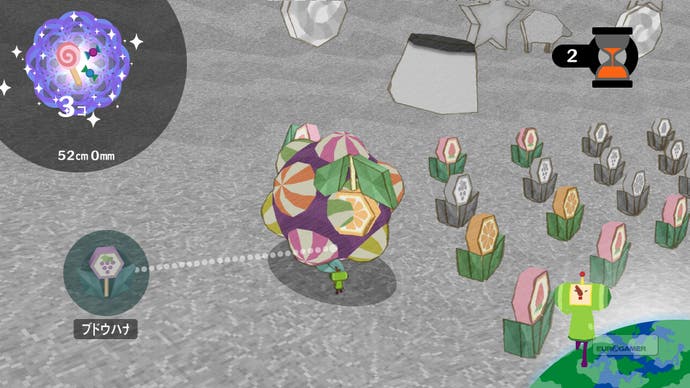Katamari Forever
Rollover jackpot?
"The game runs in full 1080p at a consistent 60 frames per second," explains a Namco employee breathlessly. "All of the camera problems that players had with the Xbox 360 title, Beautiful Katamari, have been resolved and we've given Prince a jump move, so that, by flicking the Sixaxis, players can leap out of tight corners." And indeed, the game moves smoothly, controls elegantly, and, with its collection of graphical filters, including an exquisite 'Kid's Book' crayon overlay, looks more beautiful than its predecessor ever did. But these back-of-the-box boasts, while welcome and expected, do little to demonstrate that Namco has been able to squeeze new ideas from - and applications for - the original's well-loved mechanics.
"Ah!" exclaims the demo-giver. "Let me show you this." He switches to a desert level, unexpectedly devoid of any objects to clean up. The katamari sits next to an Onsen (a Japanese bath), which is incongruously placed in the middle of the sand. "You must first soak the katamari in water," he explains, "and then paint the desert to bring life back to the area. When the water runs out you must dash back to the bath and refill it. As you restore more colour and life to the stage, so more animals and creatures are attracted. Katamari has always had a strong environmentalist theme running through the series, something we wanted to continue with in Katamari Forever."
It's a clever idea, one explored a little by THQ's excellent Wii title de Blob, and this switch of the game mechanics, from using the ball to clear up an environment to using it to restore an environment, makes repeated appearances across the game's main campaign. As ever, the story and dialogue is as leftfield and inimitable as ever. Some stages take place in the mind of your character's father, the King of All Cosmos, who is suffering from amnesia after bumping his head. In these stages you paint a black and white world with colour, restoring his memory in the process, another application of the paint-'em-up system.

Many of the classic modes from previous games make a return, one level requiring that you roll a tiny sumo wrestler around a Japanese town, each new item adding to his body mass before a final face-off with a rival wrestler. Manage to stick your opponent to your roly-poly sumo wrestler and you win the level, but bounce off him and it's instant game over, the challenge being to successfully gauge when you've collected enough items to beat your rival, while keeping an eye on the clock.
Katamari Drive is a new mode that allows you to play the entire Katamari experience at double speed, with seven minutes to grow your ball from street level to a size of 10,000 km. Then Eternal Katamari allows you free reign of the game without a time limit while the final Classic Mode promises four extra game modes that Namco is unwilling to discuss yet. There's no escaping the fact that aside from a couple of minor inventive additions, Katamari Forever is more of the same, but the welcome news is that it appears to be an awful lot more of the same.
Few games make cleaning up one's mess so compelling. While there's a sense of disappointment at having to roll up the world once again in much the same way as we have before, there are still thrills to be derived from the task. Perhaps, Katamari Forever seems to imply, our work will never be done. And perhaps that's alright: sometimes the means are more important than the ends.
Katamari Forever is due out for PS3 this autumn.


.png?width=291&height=164&fit=crop&quality=80&format=jpg&auto=webp)




.jpg?width=291&height=164&fit=crop&quality=80&format=jpg&auto=webp)
